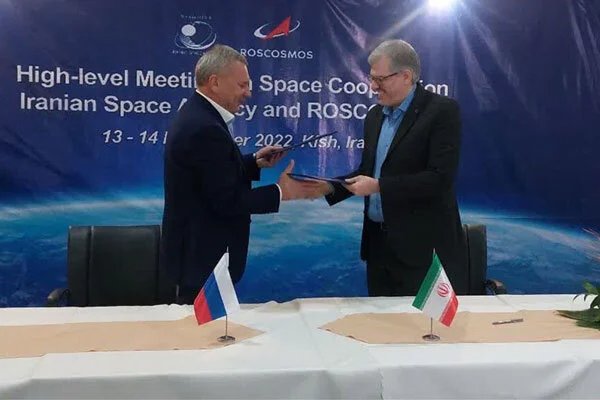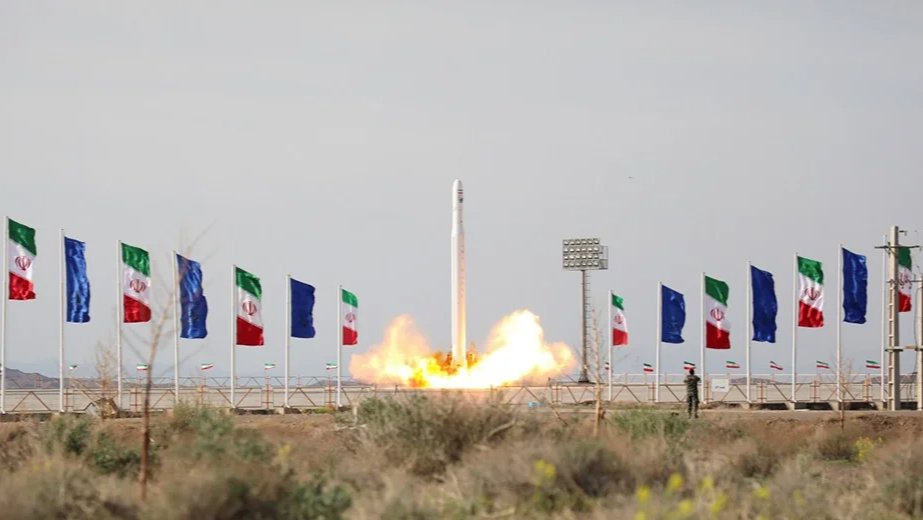Moscow is building up military and space cooperation with Tehran amid international isolation and in return for the Iranian drones. Meanwhile, Iran is willing to use this situation and adopt as much military technology from Russia as possible. Novaya Gazeta Europe has asked Ruslan Suleymanov, a journalist and an Eastern studies expert, to explain how both sides are going to benefit from this and what sort of a threat the Russo-Iranian space exploration programme hides.
Roscosmos, Russia’s state space agency, reported in early January that it had agreed on launch service cooperation with two Iranian companies, namely SAHAB and SpaceOmid. The statement does not really specify anything and only shares platitudes that the papers were signed “as a result of international events, conferences and exhibitions organised with the participation of the state corporation”.
Shortly prior to this, in December, a Roscosmos mission to Iran visited Iran AirShow 2022, an aerospace exhibition held on the Kish Island. Later on, media reported that a two-days negotiation resulted in a memorandum of cooperation being signed by Hassan Salarieh, the head of the Iranian Space Agency, and Roscosmos CEO Yury Borisov. The document says Moscow and Tehran have agreed to cooperate in creating space probes and telecommunication satellites, to hold joint tests and training, to construct lab infrastructure and even an actual launch base.
In essence, Russia and Iran had been cooperating in this domain before the Ukraine war started, too, but experts believe that Moscow and Tehran are showing maximum commitment now. Iran is willing to acquire as much military technology from Russia as possible, while the Kremlin sees it as a way to thank the Islamic Republic for the drones Russia is using against Ukraine.

Yury Borisov and Hassan Salarieh. Photo: MehrNews
Space Revolutionary Guard Corps
Iran started developing its own space programme as early as during the rule of Mohammad Reza Pahlavi, Iran’s last monarch who reigned between 1941 and 1979. In 1959, Iran was one of the founding members of the UN Committee on the Peaceful Uses of Outer Space. The creation of an Iranian satellite and a national space agency was discussed in the 1970s, but the talks were aborted when the 1979 Islamic Revolution rocked the country.
Many recent Iranian projects have been challenged by numerous international sanctions. For instance, Tehran started developing its own satellite in 1998 and named it Mesbah, the Persian word for ‘torch’. The project involved the signing of a contract with Carlo Gavazzi Space, an Italian company which could have directly participated in constructing a spacecraft and its launch to the circumterrestrial orbit. The project eventually failed due to the sanctions the UN Security Council imposed against Iran in 2006-2010 for developing its own nuclear programme.
As with Iran’s rocket technology, it was North Korea that largely helped Tehran in the 1980s. DPRK supplied 100 Hwasong-5 ballistic missiles, derived from the Soviet R-17 missiles, to Tehran in the midst of the Iran–Iraq War (1980-1988).

Hwasong-5 missile complex. Photo: Stefan Krasowski/Flickr
“In general, if we talk about Iran’s military or tech industry, any local projects are clones of some foreign ones, since the country is either in partial or even complete isolation in various domains. Those clones are simply adjusted to the local environment,” says Nikita Smagin, an expert on Iran and the creator of a large Russian-language Telegram channel about the country.
He believes, however, that Iran has had relative success in satellite launching recently: some satellites have actually reached the orbit.
Iran’s first satellite called Omid (Persian for ‘hope’) was launched on 2 February 2009 using a Safir-1 rocket. It made about 700 rotations around our planet in two months.
Apart from this, Iran’s authorities reported successful sub-orbital launches of living creatures several times. A rocket with a bio-capsule with a tortoise, a mouse, and some worms onboard, was launched from the Semnan Space Centre in February 2010. Bio-capsules with monkeys on board were mounted on rockets launched in January and December 2013.
Moreover, a prospect of sending Iran’s first astronaut into space was actively discussed during the presidency of Mahmoud Ahmadinejad (2005-2013). Right now, the country’s first manned space mission is planned for 2025. It was Ahmadinejad himself who expressed his willingness to become Iran’s first astronaut on several occasions.
“The distinctive feature of Iran’s space industry in the past five years has been that the law enforcement men have seized the initiative,” Smagin says. “All latest satellite launches were done by the Islamic Revolutionary Guard Corps (IRGC, the elite branch of the Iranian army — Novaya-Europe) rather than civilian structures as it used to be earlier.
In April 2020, IRGC reported launching the first Iranian military reconnaissance satellite called Nour (the Persian word for ‘light’) which they claimed to have completed a circumterrestrial flight at the altitude of 425 km.
The US declared back then that Iran’s development of satellite tech was only a “cover for ballistic missile activity”.
Support independent journalism
Drone fees
As said above, the cooperation between Russia and Iran in terms of space tech existed even prior to the Ukraine war. A Kosmos-3M rocket was launched from Russia’s Plesetsk site in October 2005, bringing several devices into space, including Sina-1, Earth remote sensing satellite. It was Iran’s first artificial satellite, but it was designed and created by Russia’s Polyot manufacturer. Sina-1 remains functional up to this day.
In August 2015, during the MAKS-2015 air show in Zhukovsky near Moscow, Russia’s corporation VNIIEM, and BARL, a research and production concern, signed a preliminary agreement with the Iranian company Boniyan Danesh Sharg on the development, creation and subsequent operation of a space system for remote sensing of the Earth for the interests of the Islamic Republic. According to the document, VNIIEM was responsible for developing and launching the satellite, BARL was in charge of the ground infrastructure, and Boniyan Danesh Sharg was the operator of the space system.
On August 9, 2022, the Iranian Khayyam Earth Remote Sensing Spacecraft, named after the famous Persian poet Omar Khayyam, was launched from the Baikonur Cosmodrome using a Soyuz-2.1b launch vehicle and a Fregat upper stage. Roscosmos clarified that the device was intended for scientific research, development of technologies for inter-satellite communication channels, measurement of electromagnetic radiation levels, remote sensing of the Earth, and monitoring the environmental situation.
Ali Bahadori-Jahromi, a representative of the Iranian government, later declared that Tehran was planning to construct three more satellites like Khayyam.

Amir Chahaki. Photo courtesy of the author
Amir Chahaki, an Iranian political scientist residing in Germany, is certain that the fact that the launch of Khayyam and the news about Russia purchasing Shahed-136 drones and using them in its invasion of Ukraine happened in the same period is no coincidence.
“First and foremost, what Iran needs from Russia today is military and space tech. So, Russia is somewhat repaying the fees for the drones. Among other things, the Kremlin is eager to demonstrate its appreciation to the Iranian side,” the expert says.
Amir Chahaki believes that it was Russians who named the satellite because “Omar Khayyam isn’t as popular among Iranians as he is in Russia”.
SAHAB and SpaceOmid, the Iranian companies Roscosmos signed memorandums of cooperation with, are formally private, but are de facto run by the state: the military space sector is controlled by the Islamic Republic’s authorities exclusively, Chahaki says.
Meanwhile, the expert believes, Vladimir Putin is boosting military tech cooperation with Iran to take revenge on Turkey in his own fashion, since Turkey is supplying its drones to the Ukrainian army. “Since Putin is very rancorous, he might as well still be taking revenge on Ankara for the Su-24 bomber taken down at the Turkey-Syria border in November 2015 when the Russian pilot was killed,” Chahaki believes.

Nikita Smagin. Photo courtesy of the author
On the other hand, Nikita Smagin believes that, even putting the drones thing aside, Moscow and Tehran are interested in boosting military space cooperation with each other like never before.
“For Iran, cooperation with Russia is, in my opinion, a chance to improve its own weak spots. For Moscow, the space industry is one of those worthy of building relationships with Iran since Iranians are one of the very few Kremlin’s partners today,” the expert believes.
Yury Borisov, the head of Roscosmos who replaced Dmitry Rogozin in July 2022, shared his sharply-worded and somewhat exultant comment during his visit to Iran in December. “We are all witnessing the historic bonding of our two countries, Russia and Iran, on the global arena. <…> Our country has ample experience in this domain, we are the pioneers of space exploration, and we are ready to share our accomplishments with the Iranian people,” the Roscosmos CEO said.
Join us in rebuilding Novaya Gazeta Europe
The Russian government has banned independent media. We were forced to leave our country in order to keep doing our job, telling our readers about what is going on Russia, Ukraine and Europe.
We will continue fighting against warfare and dictatorship. We believe that freedom of speech is the most efficient antidote against tyranny. Support us financially to help us fight for peace and freedom.
By clicking the Support button, you agree to the processing of your personal data.
To cancel a regular donation, please write to [email protected]

